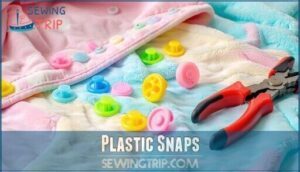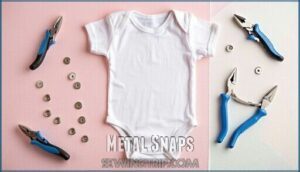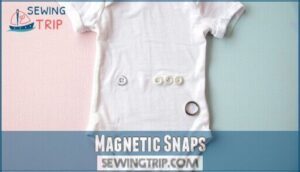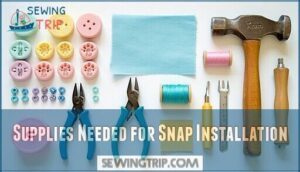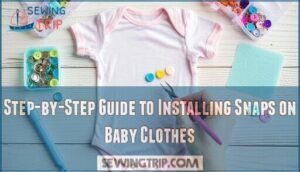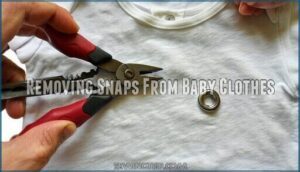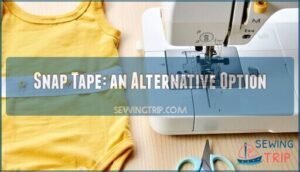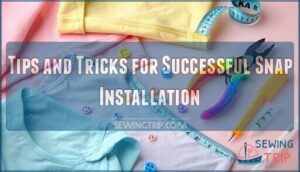This site is supported by our readers. We may earn a commission, at no cost to you, if you purchase through links.
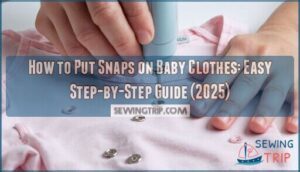 You’ll need snap fasteners, a snap press tool or pliers, and fabric scissors to put snaps on baby clothes.
You’ll need snap fasteners, a snap press tool or pliers, and fabric scissors to put snaps on baby clothes.
Start by marking exact placement points where you want the snaps, ensuring they align properly when the garment closes.
Use your awl or sharp tool to create small holes in the fabric at each mark. Insert the snap’s cap piece through the hole from the right side, then attach the socket or stud piece from the wrong side.
Press firmly with your tool until the pieces lock together securely. Test each snap’s strength before finishing. The right technique makes all the difference in creating professional-looking results, with a focus on making the snaps strong.
Table Of Contents
- Key Takeaways
- The Basics of Snap Installation
- Types of Snaps for Baby Clothes
- Choosing The Right Size Snap
- Supplies Needed for Snap Installation
- Step-by-Step Guide to Installing Snaps on Baby Clothes
- Removing Snaps From Baby Clothes
- Benefits of Using Snaps on Baby Clothes
- Snap Tape: an Alternative Option
- Where to Buy Quality Snaps for Baby Clothes
- Tips and Tricks for Successful Snap Installation
- Frequently Asked Questions (FAQs)
- Conclusion
Key Takeaways
- You’ll need snap fasteners, snap press pliers, fabric scissors, and an awl to install snaps properly, with size 16 plastic snaps being ideal for baby clothes since they’re gentler on delicate fabrics and easier for little fingers to manage.
- Mark your snap placement carefully with pins, create small holes with an awl, then insert the cap piece from the right side and attach the socket or stud from the wrong side using steady pressure with your pliers.
- Reinforce delicate fabrics with interfacing before installation to prevent tearing, and always test each snap’s strength after installation to ensure it’ll withstand repeated use and washing cycles.
- Choose plastic snaps over metal ones for baby clothes because they’re allergen-free, rust-resistant, lightweight, and safer for sensitive skin, while magnetic snaps should be avoided due to choking hazards if they separate from the fabric.
The Basics of Snap Installation
Installing baby clothes snaps requires proper technique and the right approach.
Master the art of snap installation—your baby’s comfort depends on getting it right the first time.
Start with fabric reinforcement by adding interfacing to strengthen delicate materials before snap application. Tool selection matters – choose quality snap pliers designed for baby garments.
Mark your snap placement carefully, ensuring proper snap alignment between matching pieces. Create small holes using an awl, then position caps on the fabric’s right side for outer snaps.
Secure fastening comes from applying steady pressure with pliers. Remember, snap fasteners need precise installation to function safely and effectively on your little one’s clothing.
Types of Snaps for Baby Clothes
You’ll find three main types of snaps available for baby clothes: plastic, metal, and magnetic options.
Each type offers different benefits and drawbacks, so you’ll need to take into account factors like safety, durability, and ease of use when making your selection.
Plastic Snaps
Plastic snaps are the go-to choice for baby clothes snaps, offering unmatched plastic durability that withstands countless wash cycles. You’ll love the extensive color options available, from soft pastels to vibrant hues that match any outfit.
Plastic snaps bring both safety and style to your baby’s wardrobe with unbeatable durability.
These snaps are completely allergen free, making them safe for sensitive baby skin, while their rust resistance guarantees they’ll never stain delicate fabrics.
The affordability factor makes plastic snaps budget-friendly for parents and crafters alike. KAM plastic snaps represent the gold standard, measuring 12.4mm in diameter and engineered from high-grade polyacetal resin.
Using snap pliers designed for snap application, you can install these lightweight fasteners quickly. Considering different materials is important, so you may want to select organic cotton for your baby’s clothing.
Their hypoallergenic composition meets international safety standards, giving you peace of mind with every garment closure.
Metal Snaps
When choosing metal snaps for baby clothes, you’re investing in long-lasting fasteners with superior aesthetic appeal.
These stainless steel components offer excellent rust prevention and handle repeated washing cycles better than alternatives. Metal snaps require specialized snap pliers and installation tools for proper attachment, but their durability concerns are minimal with correct technique.
However, be aware that utility snaps may be too stiff for delicate baby fabrics.
Key advantages that make parents choose metal snaps:
- Classic elegance that elevates any baby garment’s appearance
- Superior strength withstanding over 10,000 opening cycles
- Fabric compatibility working seamlessly across delicate to sturdy materials.
Your snap installation guide starts with proper tool selection.
Magnetic Snaps
Magnetic snaps provide unmatched closure reliability through their invisible magnetic strength, making them perfect for quick diaper changes and fussy nighttime dressing.
You’ll find these snap fasteners incredibly convenient during sewing projects since they eliminate alignment struggles common with traditional options.
However, safety concerns limit their garment applications for baby clothes. The powerful magnets pose choking hazards if they separate from fabric during wear or washing.
Considering potential safety problems is essential before using magnetic snaps. Most pediatric safety experts recommend alternative closures like plastic or metal snap fasteners for infant clothing.
While magnetic snaps excel in adult garments, stick with safer snap installation methods when crafting clothes for your little ones.
Choosing The Right Size Snap
Getting the perfect snap size for your baby clothes isn’t rocket science, but it makes all the difference. You’ll want to match snap sizes to your project’s specific needs rather than grabbing whatever’s handy.
Consider these key factors when selecting snap sizes:
- Fabric Thickness – Lightweight cotton needs smaller T3 snaps, while thicker knits require T5 sizes
- Baby Size – Newborns benefit from gentler T3 snaps that won’t dig into delicate skin
- Intended Use – Onesies need frequent opening, so choose snaps that balance security with easy release
- Snap Strength – Heavy-wear items like rompers need stronger snaps than decorative applications
KAM snaps offer reliable sizing standards across baby clothing projects. Size 16 works well for most baby clothes, providing adequate snap strength without being too aggressive. Your snap pliers should match your chosen size for proper installation.
Consider your aesthetic preference too – smaller snaps create cleaner lines on delicate garments. Matching snaps to fabric weight is essential for ensuring a secure and lasting hold.
Supplies Needed for Snap Installation
Before you start installing snaps, you’ll need the right tools to get the job done properly.
Having everything ready beforehand saves frustration and guarantees professional results.
Here’s what you’ll need for snap installation:
- KAM snaps – Choose size 16 for baby clothes (easier to open and gentler on delicate fabrics)
- Snap pliers – KAM snap pliers work best for consistent, secure attachment
- Awl tool – Creates precise holes without damaging fabric fibers
- Interfacing fabric – Reinforces thin materials where snaps attach
- Hammer set – Alternative to pliers for manual installation
- Thread spool – Protects fabric surface when hammering snaps
Quality snap tools make installation smoother and more reliable.
Consider using specialized snap presses for superior results.
Step-by-Step Guide to Installing Snaps on Baby Clothes
Installing snaps on baby clothes requires careful marking, precise hole creation, and proper attachment techniques to guarantee secure fastening.
You’ll work through four main steps: marking snap placement, creating fabric holes, attaching caps and socket/stud components, and securing everything in place for long-lasting results.
Marking The Snap Placement
Perfect snap placement transforms chaotic baby clothes into organized masterpieces.
Use pins for Pin Marking snap positions on your fabric, ensuring both sides align when closed.
An Awl Usage creates precise starter holes through the Fabric Interface.
Always install the Stud First, then mark corresponding socket locations for Accurate Socket positioning.
A precise snap placement tool can also improve accuracy.
| Marking Tool | Best For |
|---|---|
| Fabric pins | Initial placement marking |
| Washable fabric marker | Temporary visible marks |
| Awl or stiletto | Creating precise pilot holes |
| Measuring tape | Consistent spacing between snaps |
| Template or ruler | Professional alignment results |
Creating Holes in The Fabric
Once you’ve marked your snap placement, you’ll need to create clean holes in the fabric.
An awl works best for most baby clothes, creating precise openings without fraying. For thicker fabrics, consider using a small hole punch or scissors as an alternative.
Check your hole size matches your Kam snaps – too large and they’ll slip through, too small and installation becomes difficult.
Attaching The Cap and Socket/Stud
Line up your snap components like puzzle pieces waiting to connect.
Socket placement starts with positioning the cap over the prong that’s pushed through your baby clothes fabric.
- Align the cap’s black center with your pliers’ grooves for perfect positioning
- Feel the satisfying click as metal meets fabric in your hands
- Watch components lock together like they were meant to be
- Trust the process – your Kam snaps won’t let you down
Securing The Snaps in Place
After placing your cap and socket components, securing them properly prevents snap detachment down the road. Apply steady hammering force with your setting tool, using three firm taps rather than gentle nudges.
For KAM snaps on baby clothes, consistent pliers pressure guarantees durability. Test each snap’s grip—it should hold firmly without excessive force needed for opening.
| Securing Method | Tool Required | Best For |
|---|---|---|
| Hammer setting | Snap setter + hammer | Metal snaps on thick fabric |
| Pliers installation | KAM snap pliers | Plastic snaps, quick projects |
| Hand pressing | Snap press tool | Delicate baby clothes |
| Reinforcement stitching | Needle + thread | Extra security needed |
| Setting tool method | Curved setting tool | Professional finish |
Removing Snaps From Baby Clothes
Sometimes you’ll need to remove worn-out snaps from baby clothes for replacing snaps or switching to alternative closures. Use diagonal pliers as your primary snap removal tools, opening them wide to grip the snap components while pulling fabric away to guarantee fabric damage prevention.
Here’s what successful snap removal looks like:
- Clean fabric surface with no torn threads or holes
- Intact snap components ready for reusing removed snaps
- Smooth fabric edges prepared for new fasteners
Work slowly with gentle pressure to avoid repairing snap damage later during your sewing project, ensuring a smooth fabric edge is maintained.
Benefits of Using Snaps on Baby Clothes
Now that you know how to remove snaps when needed, let’s explore why they’re the go-to choice for baby clothing fasteners. Snaps offer unmatched advantages that make your parenting journey smoother and safer.
Safety Concerns top the list – snaps integrate tightly into fabric, preventing curious babies from pulling them off like buttons. This snap closure design eliminates choking hazards that keep parents awake at night.
For ideal comfort, consider breathable natural fabrics for your baby’s clothing.
Ease Fastening becomes your best friend during those 3 AM diaper changes. One quick press secures the snap, unlike fumbling with tiny buttonholes on a squirming baby.
| Benefit | Traditional Buttons | Snap Closure |
|---|---|---|
| Safety Risk | High choking hazard | Secure integration |
| Speed | Slow, requires precision | Quick one-press action |
| Durability | Threads can break | Long-lasting hold |
Garment Durability means your baby clothes withstand countless wash cycles. Quality snaps maintain their grip through growth spurts and active playtime, while Cost Effectiveness shines when clothes last longer and work for multiple children.
Snap Tape: an Alternative Option
Snap tape offers a game-changing alternative to individual snaps for baby clothes.
This pre-assembled fabric strip contains evenly spaced snaps, eliminating tedious one-by-one installation.
Snap tape uses include pocket flaps, romper inseams, and jacket closures.
Application methods involve straight stitching along both edges using matching thread.
Snap tape installation requires standard sewing machine techniques, making it beginner-friendly.
Snap tape advantages include consistent spacing, professional appearance, and time savings.
Durability comparison shows snap tape withstands repeated washing cycles.
Cost analysis reveals snap tape provides excellent value for multiple-snap projects on baby clothes.
Where to Buy Quality Snaps for Baby Clothes
Finding the right supplier makes all the difference when shopping for baby clothes snaps.
You’ll discover quality options through the KAM Website, which offers reliable plastic snaps perfect for little ones.
Etsy Options provide unique colors and bulk buying opportunities from independent sellers.
Brand Comparison between KAM snaps and Snap Source helps you choose durability over price.
Local Retailers like craft stores stock basic supplies, while online shopping platforms offer extensive selections.
Consider purchasing in bulk if you’re planning multiple projects—it’s more economical than buying individual packages, and helps with bulk buying opportunities and choosing durability.
Tips and Tricks for Successful Snap Installation
Now that you know where to find quality snaps, mastering the installation process makes all the difference.
Here are five essential tips for snap installation success:
- Master the Pliers Technique – Use KAM snap pliers designed specifically for snap setting tutorial work
- Interfacing Matters – Add interfacing under delicate fabrics for fabric stability
- Alignment Accuracy – Mark placement carefully before creating holes
- Stitch Reinforcement – Secure snaps with extra stitching around perimeters
- Practice Makes Perfect – Try snap installation techniques on fabric scraps first
These sewing tips guarantee professional-looking baby clothes every time.
For superior results, remember to take into account fabric thickness beforehand.
Frequently Asked Questions (FAQs)
Can Snaps Be Used on Delicate Baby Fabrics?
While delicate fabrics might seem too fragile, you can absolutely use snaps on them.
Choose size 16 snaps with shorter prongs, reinforce with interfacing, and they’ll work perfectly without damaging your precious baby garments.
Are Magnetic Snaps Safe to Use on Baby Clothes?
Magnetic snaps are generally safe for baby clothes when properly manufactured and tested.
They’re securely encased to prevent separation, comply with safety standards, and work great for ages 0-24 months with careful installation.
What is the Difference Between Plastic and Metal Snaps?
Like choosing between a feather and a pebble, plastic snaps are lightweight, colorful, and rust-resistant, while metal snaps offer superior strength and durability but can corrode with repeated washing cycles.
Can Snap Tape Be Used for All Areas of Baby Clothing?
Snap tape works well for straight seams like romper crotches and onesie sides.
But it’s not suitable for curved areas, necklines, or shoulder openings where individual snaps provide better flexibility and fit, particularly for complete concepts that require a more tailored approach.
Where Can I Purchase Quality Snaps for Baby Clothes?
Over 95% of baby clothing manufacturers rely on specialized snap suppliers for consistent quality.
You’ll find top-grade snaps at KAM’s website, Etsy for variety, or local fabric stores like Black Rabbit Fabric for immediate needs.
How to attach snaps to baby clothes?
Choose size 16 plastic snaps for delicate baby fabric. Mark placement with pins, push prongs through using a pencil eraser, align socket pieces, then hammer gently using thread spools for protection.
Are snaps safe on baby clothes?
Gentle fasteners pose no threat to your little one’s well-being.
You’ll find snaps integrate tightly into clothing, preventing removal unlike buttons that create choking hazards.
They’re specifically designed for children’s garments and meet safety standards.
How do I put snaps on clothing?
Position your fabric where you want the snap,
push the prong through using a pencil eraser,
align the socket or stud with grooves.
Then hammer into place using a thread spool for protection.
What size snaps for baby clothes?
Finding the perfect snap size can make or break your project.
You’ll want size 16 snaps for most baby clothes—they’re gentler on delicate fabrics and easier for little fingers to manage than larger alternatives.
Can snaps be used on delicate baby fabrics?
Yes, you can use snaps on delicate baby fabrics. Size 16 snaps work best since they’ve shorter prongs and gentler grip. Always interface thin fabrics first for added strength and stability.
Conclusion
Picture your baby’s outfit closing effortlessly with perfectly aligned snaps that won’t budge during playtime.
Mastering how to put snaps on baby clothes transforms ordinary garments into practical, professional-looking pieces.
You’ve learned the essential techniques, from marking placement to securing each component properly.
With quality materials and careful attention to detail, you’ll create durable closures that withstand countless washes and wear.
Your newfound skills guarantee every snap functions smoothly while keeping your little one comfortable and stylish.

